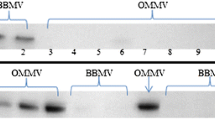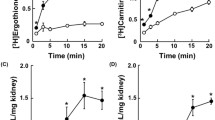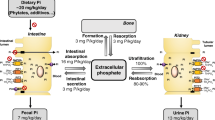Abstract
The effect of substituted benzoylglycines (hippurates) and phenylacetylglytines on the transport of p-aminohippurate (PAH) was studied in basolateral (BLMV) and brush border membrane vesicles (BBMV) isolated from dog kidney cortex. The probenecid-sensitive part of 100 µM [3H]PAH uptake into BLMV and BBMV was measured in the presence and absence of 5 mM glycine conjugate. The benzoyl- and phenylacetylglycines studied were substituted in the 2-, 3-, or 4-position with an H, CH3, OCH3 or OH group. Benzoylglycines were stronger inhibitors of PAH transport than phenylacetylglycines and the inhibitory potency of the conjugates was in general lower against the transporter in BBMV than BLMV. The specificities of the transporters in both membranes appear to be very similar. The inhibitory potency of the benzoylglycines, expressed as the apparent inhibition constant (logK i), did not show a linear relationship with their lipophilicity as determined by reversed phase HPLC. Deviation from linearity was caused mainly by the 3-OH and 4-OH analogs, which showed a greater inhibitory potency than expected from their lipophilicity. Phenylacetylglycines only showed a small variation in logK i, values, indicating that insertion of a CH2 group between the ring and the carbonyl practically abolishes the influence of the ring and its substituents. In conclusion, both hydrophobic and electronic properties are important determinants of affinity for the PAH transport system. An additional partially negative hydroxyl group in the ring, located preferably at the 3- or 4-position, increases the interaction with the transport system.
Similar content being viewed by others
REFERENCES
J. Caldwell. Conjugation of xenobiotic carboxylic acids. In W. B. Jakoby, J. R. Bend, and J. Caldwell (eds.), Metabolic Basis of Detoxication, Academic Press, New York, 1982, pp. 271–290.
J. V. Møller and M. I. Sheikh. Renal organic anion transport system: Pharmacological, physiological and biochemical aspects. Pharmacol. Rev. 34:315–358 (1983).
J. B. Pritchard and D. S. Miller. Proximal tubular transport of organic anions and cations. In D. W. Seldin and G. Giebisch (eds.), The Kidney: Physiology and Pathophysiology, Second Edition, Raven Press, New York, 1992, pp. 2921–2945.
P. K. Knoefel and K. C. Huang. The biochemorphology of renal tubular transport: iodinated benzoic acids. J. Pharmacol. Exp. Ther. 117:307–316 (1956).
J. J. Grantham and A. M. Chonko. Renal handling of organic anions and cations; Metabolism and excretion of uric acid. In B. M. Brenner, F. C. Rector (eds.), The Kidney, WB Saunders, Philadelphia, 1986, pp. 663–700.
A. Despopoulos. A definition of substrate specificity in renal transport of organic anions. J. Theoret. Biol. 8:163–192 (1965).
A. Essig and J. V. Taggert. Competitive inhibition of renal transport of p-aminohippurate by other mono-substituted hippurates. Am. J. Physiol. 199:509–512 (1960).
K. J. Ullrich and G. Rumrich. Contraluminal transport systems in the proximal renal tubule involved in secretion of organic anions. Am. J. Physiol. 254:F453–F462 (1988).
K. J. Ullrich, G. Rumrich, and S. Klöss. Contraluminal para-aminohippurate (PAH) transport in the proximal tubule of the rat kidney IV. Specificity: mono-and polysubstituted benzene analogs. Pflügers Arch. 413:134–146 (1988).
K. J. Ullrich, G. Rumrich, and S. Klöss. Contraluminal organic anion and cation transport in the proximal renal tubule: V. Interaction with sulfamoyl-and phenoxy diuretics, and with beta-lactam antibiotics. Kidney Int. 36:78–88 (1989).
K. J. Ullrich, G. Rumrich, Th. Wieland, and W. Dekant. Contraluminal para-aminohippurate (PAH) transport in the proximal tubule of the rat kidney VI. Specificity: Amino acids, their N-methyl, N-acetyl-and N-benzoylderivatives; glutathione-and cysteine conjugates, di-and oligopeptides. Pflügers Arch. 415:342–350 (1989).
K. J. Ullrich, G. Rumrich, F. Papavassiliou, S. Klöss, and G. Fritzsch. Contraluminal para-aminohippurate (PAH) transport in the proximal tubule of the rat kidney VII. Specificity: cyclic nucleotides, eicosanoids. Pflügers Arch. 418:360–370 (1991).
K. J. Ullrich, G. Rumrich, F. Papavassiliou, and K. Hierholzer. Contraluminal para-aminohippurate (PAH) transport in the proximal tubule of the rat kidney VIII. Transport of corticosteroids. Pflügers Arch. 418:371–382 (1991).
G. Fritzsch, G. Rumrich, and K. J. Ullrich. Anion transport through the contraluminal cell membrane of renal proximal tubule. The influence of hydrophobicity and molecular charge distribution on the inhibitory activity of organic anions. Biochim. Biophys. Acta 978:249–256 (1989).
F. G. M. Russel, M. Heijn, R. C. de Laet, and C. A. M. van Ginneken. Effect of substituted benzoates on p-aminohippurate transport in dog renal membrane vesicles. Naunyn-Schmied. Arch. Pharmacol. 343:102–107 (1991).
S. E. Guggino, G. J. Martin, P. S. Aronson. Specificity and modes of the anion exchanger in dog renal microvillus membranes. Am. J. Physiol. 244:F612–F621 (1983).
K. J. Ullrich, G. Rumrich, S. Klöss, and H. Fasold. Reabsorption of monocarboxylic acids in the proximal tubule of the rat kidney III. Specificity for aromatic compounds. Pflügers Arch. 395:227–231 (1982).
F. G. M. Russel, P. E. M. van der Linden, W. G. Vermeulen, M. Heijn, C. H. Van Os, and C. A. M. van Ginneken. Na+ and H+ gradient-dependent transport of p-aminohippurate in membrane vesicles from dog kidney cortex. Biochem. Pharmacol. 37:2639–2649 (1988).
T. Yamana, A. Tsuji, E. Miyamaoto, and O. Kubo. Novel method for determination of partition coefficients of penicillins and cephalosporins by high-performance liquid chromatography. J. Pharm. Sci. 66:747–749 (1977).
A. Vogel. Vogel's Practical Organic Chemistry, Longman, London, 1978, p. 885.
S. M. McElvain and T. P. Carney. Piperidine derivatives. XVII. Local anesthetics derived from substituted piperidino alcohols. J. Am. Chem. Soc. 68:2592–2600 (1946).
W. van Brussel and C. F. van Sumere. N-Acylamino acids and peptides. VI. A simple synthesis of N-acylglycines of the benzoyl and cinnamyl type. Bull. Soc. Chim. Belg. 87:791–797 (1978).
E. Solheim and R. R. Scheline. Metabolism of alkene benzene derivatives in the rat. I. p-Methoxyallylbenzene (estragole) and p-methoxypropenylbenzene (anethole). Xenobiot. 3:493–510 (1973).
J. W. ApSimon, D. G. Durham, and A. H. Rees. Synthesis of some 2-phenylpyrolle derivatives. J. Chem. Soc. Perkin. Trans. 12:1588–1594 (1978).
Beilstein's Handbuch der Organischen Chemie, Vierte Auflage, Band IX, Julius Springer, Berlin, 1926, pp. 465, 477, 487.
A. J. Quick. The site of the synthesis of hippuric acid and phenylaceturic acid in the dog. J. Biol. Chem. 90:73–82 (1932).
E. Salkowski and H. Salkowski. Ueber das verhalten der phenylessigsaüre und phenylpropionsaüre im Organismus. Berichte 12:653–655 (1879).
F. G. M. Russel, A. C. Wouterse, and C. A. M. van Ginneken. Renal clearance of substituted hippurates in the dog. I. Benzoylgycine (hippurate) and methyl-substituted benzoylglycines. J. Pharmacol. Exp. Ther. 248:428–35 (1989).
F. G. M. Russel, A. C. Wouterse, and C. A. M. van Ginneken. Renal clearance of substituted hippurates in the dog. II. 4-Amino-, hydroxy-and methoxy-substituted benzoylglycines. J. Pharmacol. Exp. Ther. 248:436–46 (1989).
Author information
Authors and Affiliations
Rights and permissions
About this article
Cite this article
Russel, F.G.M., Vermeulen, W.G. Effect of Substituted Benzoylglycines (Hippurates) and Phenylacetylglycines on p-Aminohippurate Transport in Dog Renal Membrane Vesicles. Pharm Res 11, 1829–1833 (1994). https://doi.org/10.1023/A:1018992106452
Issue Date:
DOI: https://doi.org/10.1023/A:1018992106452




